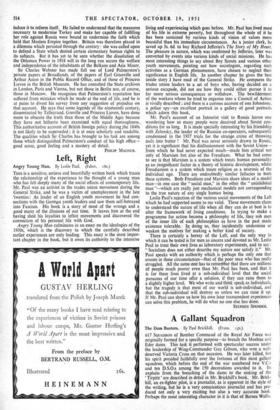A Gallant Squaclion
The Dam Busters. By "Paul Brickhill. (Evans. iss.) 617 SQUADRON of Bomber Command of the Royal Air Force was originally formed for a specific purpose—to breach the Moehne and Eder dams. This task it performed with spectacular success 'under the leadership of Wing-Commander Guy Gibson, who won a -well- deserved Victoria Cross on that occasion. He was later killed, but his spirit presided faithfully over the fortunes of this most gallant squadron, which before the end of the war numbered two V.C.s and ten D.S.O.s among the 150 decorations awarded to it. Its exploits from the breaching of the dams to the- sinking of the Tirpitz ' are described in detail in Mr. Brickhill's book. Mr. Brick- hill, an ex-fighter pilot, is a journalist, as is apparent in the style bf the writing, but he is a very conscientious journalist and has pro- duced not only a very exciting but also a very accurate book. Perhaps the most interesting character in it is that of Barnes Wallis, the white-haired inventor of genius, who designed the Wellington, produced the weapon which destroyed the darns, and that grimmest. bomb of all, the Grand Slam, which sank the Tirpitz.' For these and other inventions a grateful country awarded him a sum of £10,000. On receiving it " he immediately put it into a fund to help educate the sons and daughters of men who died serving the Royal Air Force." Comment is unnecessary as it would be impertinent. • As its title implies, about a third of the book is devoted to a # description derived mostly from those who took part in the opera- tion of the attack on the Moehne and Eder dams. Its planning and execution entitled it to be described as unique. 617 Squadron came into being on March 21st, 1943, and the operation took place on the night of May 16th-17th. In that--brief space of time all the crews learnt to fly with complete accuracy in pitch darkness at very low levels—perhaps the most difficult feat that a pilot of a heavy bomber can be called upon to perform. They attacked the dams from a height of 50 feet, and the timing had literally to be to the split second. When it was all over Harris, the fierce Chief of Bomber Command, rightly realised that to disband such a squadron would be to dis- perse experts who, if they continued to remain together, might be used against special targets. They were so used, and among the targets were the flying-bomb sites, the hidden guns of Mimoyecques trained on London, the Bielefeld viaduct, and finally Berchtesgaden itself, where a •large bomb enormously increased the depth of Goering's swimming pool. These and other exploits form the theme of a book which should certainly buead. Am( ST. GEORGE SAUNDERS.



































 Previous page
Previous page